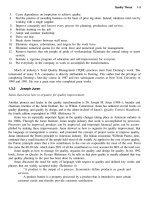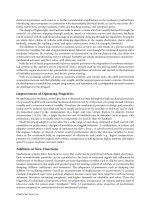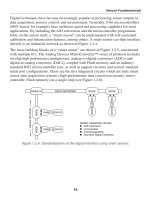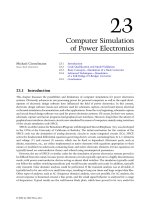The VLSI Handbook P2
Bạn đang xem bản rút gọn của tài liệu. Xem và tải ngay bản đầy đủ của tài liệu tại đây (589.13 KB, 20 trang )
1
-8
The VLSI Handbook
© 2006 by CRC Press LLC
The preferred profile to achieve a good compromise between a too high field at the base-collector
junction and suppression of the Kirk effect at high current densities is obtained by a retrograde collector
profile [30]. For this profile the SIC implantation energy is chosen to obtain a low impurity concentration
near the base-collector junction and then increasing toward the subcollector.
The thickness of the epilayer exhibits large variations among different device designs, extending several
micrometers in depth for analog bipolar components, whereas a high-speed digital design typically has
an epilayer thickness around 1 µm or below, thus reducing the total collector resistance. As a result, the
transistor breakdown voltage is sometimes determined by reach-through breakdown (i.e., full depletion
of penetration of the epicollector). The thickness of the collector layer can therefore be used as a parameter
in determining BV
CEO
, which in turn is traded off against f
T
.
In cases where f
max
is of interest, the collector design must be carefully taken into account. Compared
with f
T
, the optimum f
max
is found for thicker and less doped collector epilayers [32, 33]. The vertical
collector design will therefore, to a large extent, determine the trade-off between f
T
and f
max
.
1.2.5 Base Region
The width and peak concentration of the base profile are two of the most fundamental parameters in
vertical profile design. In a conventional Si bipolar process the base width is limited by the implantation
energy and to some extent the collector doping, since an implanted profile will have a Gaussian tail
toward the collector. The base width W
B
is normally in the range 0.1–1 µm, whereas a typical base peak
concentration lies between 10
17
and 10
18
cm
–3
. In contrast to this, base widths of <100 Å [34] with peak
doping close to 10
20
cm
–3
can be achieved by SiGe epitaxy including a small amount of carbon for added
profile control. The integral of the base doping over the base width is known as the Gummel number.
The current gain of the transistor is determined by the ratio of the Gummel number in the emitter and
base. In an SiGe transistor, the current gain is also strongly (exponentially) dependent on the Ge
concentration in the base and therefore a higher base doping can be used without sacrificing gain. Usually,
a current gain of at least 100 is required for analog bipolar transistors, whereas in digital applications, a
β value around 20 is often acceptable. A normal base sheet resistance (or pinch resistance) for conventional
bipolar processes is of the order of 100 Ω/sq, whereas the number for high-speed devices (implanted or
epitaxial base) typically is in the interval 1 to 10 kΩ/sq [3]. This is due to the small W
B
(<0.1 µm)
necessary for a short base transit time. However, a too narrow base will have a negative impact on f
max
because of its R
B
dependence. As a result, f
T
and f
max
exhibit a maximum when plotted against W
B
[35]
or base doping [36].
FIGURE 1.4 Vertical impurity doping profile with a SIC for a 50 GHz f
T
/f
max
Si-bipolar/BiCMOS technology
(from Malm, B. G. et al., IEEE Trans. Electron Dev. vol. 52, 1423, 2005).
10
16
10
17
10
18
10
19
10
20
0.0 0.80.60.40.2
Concentration (atoms/cm
3
)
Depth (m)
10
21
Phosphorus
Boron
Arsenic
4199_C001.fm Page 8 Monday, October 23, 2006 5:57 PM
Bipolar Technology 1-9
© 2006 by CRC Press LLC
The base impurity concentration must be kept high enough to avoid punch-through at low collector
voltages; that is, the base-collector depletion layer penetrates across the neutral base. In other words, the
base doping level is also dictated by the collector impurity concentration. Punch-through is the ultimate
consequence of base width modulation or the early effect manifested by a finite output resistance in the
I
C
–V
CE
transistor characteristic [37]. The associated V
A
or the product β × V
A
serves as an indicator of
the linear properties for the bipolar transistor. The V
A
is typically at a relatively high level (>30 V) for
analog applications, whereas digital designs often accept relatively low V
A
(<15 V).
A limiting factor for high base doping numbers above 5 × 10
18
cm
–3
is the onset of forward-biased
tunneling currents in the emitter-base junction leading to nonideal base current characteristics [38].
Since the tunneling current is dependent on mid-bandgap states induced by process steps such as
implantation, significantly lower tunneling has been reported for epitaxial base devices [39]. Therefore,
base dopings well above 10
19
cm
–3
can be used in SiGe HBTs, with no significant nonideality observed
in the base current.
The shape of the base profile has some influence on the device performance. The final base profile is
the result of an implantation and diffusion process and, normally, only the peak base concentration is
given along with the base width. Nonetheless, there will be an impurity grading along the base profile
(see Figure 1.2 and Figure 1.4), creating a built-in electrical field and thereby adding a drift component
for the minority carrier transport [40]. For very narrow base transistors, the uniform doping profile is
preferable when maximizing f
T
[41, 42]. This is also valid under high injection conditions in the base [43].
Uniformly doped base profiles are common in advanced bipolar processes using epitaxial techniques for
growing the intrinsic base.
1.2.6 Emitter Region
The conventional metal-contacted emitter is characterized by an abrupt arsenic or phosphorus profile
fabricated by direct diffusion or implantation into the base area (see Figure 1.2) [44]. In keeping emitter
efficiency close to unity (and thus high current gain), the emitter junction cannot be made too shallow
(~1 µm). The emitter doping level lies typically between 10
20
and 10
21
cm
–3
close to the solid solubility
limit at the silicon surface, hence providing a low emitter resistance as well as a large emitter Gummel
number required for keeping current gain high. Bandgap narrowing, however, will be present in the
emitter, causing a reduction in the efficient emitter doping [45].
When scaling bipolar devices, the emitter junction must be made shallower to ensure a low emitter-
base capacitance. When the emitter depth becomes less than the minority carrier recombination length,
the current gain will inevitably degrade. This precludes the use of conventional emitters in a high-
performance bipolar technology. Instead, polycrystalline (poly) silicon emitter technology is utilized. By
diffusing impurity species from the polysilicon contact into the monocrystalline (mono) silicon, a very
shallow junction (<0.2 µm) is formed; yet gain can be kept at a high level and even traded off against a
higher base doping [46]. A gain enhancement factor between 3 and 30 for the polysilicon compared with
the monosilicon emitter has been reported (see also Section 1.4) [47, 48].
1.2.7 Horizontal Layout
The horizontal layout is carried out to minimize the device parasitics. Figure 1.5 shows the essential
parasitic resistances and capacitances for a schematic bipolar structure containing two base contacts. The
various RC constants in Figure 1.5 introduce time delays. For conventional bipolar transistors, such
parasitics often limit device speed. In contrast, the self-alignment technology applied in advanced bipolar
transistor fabrication allows for efficient suppression of the parasitics.
In horizontal layout, f
max
serves as a first-order indicator in the extrinsic optimization procedure
because of its dependence on C
BC
and (total) R
B
. These two parasitics are strongly connected to the
geometrical layout of the device. The more advanced t
d
calculation takes all major parasitics into account
under given load conditions, thus providing good insight into the various time delay contributions of a
bipolar logic gate [49].
4199_C001.fm Page 9 Monday, October 23, 2006 5:57 PM
1-10 The VLSI Handbook
© 2006 by CRC Press LLC
From Figure 1.5, it is seen that the collector resistance is divided into three parts. Apart from the
epilayer and buried layer previously discussed, the collector contact also adds a series resistance. Provided
the epilayer is not too thick, the transistor is equipped with a deep phosphorus plug from the collector
contact down to the buried layer, thus reducing the total RC.
As illustrated in Figure 1.5, the base resistance is divided into intrinsic (R
Bi
) and extrinsic (R
Bx
)
components. The former is the pinch-base resistance situated directly under the emitter diffusion, whereas
the latter constitutes the base regions contacting the intrinsic base. The intrinsic part decreases with the
current owing to the lateral voltage drop in the base region [50]. At high current densities, this causes
current crowding effects at the emitter diffusion edges. This results in a reduced onset for high-current
effects in the transistor. The extrinsic base resistance is bias independent and must be kept as small as
possible (e.g., by utilizing self-alignment architectures). By designing a device layout with two or more
base contacts surrounding the emitter, the final R
B
is further reduced at the expense of chip area. Apart
from enhancing f
max
, the R
B
reduction is also beneficial for device noise performance.
The layout of the emitter is crucial since the effective emitter area defines the intrinsic device cross
section [51]. The minimum emitter area, within the lithography constraints, is determined by the
operational collector current and the critical current density, where high-current effects start to occur [52].
Eventually, a trade-off must be made between the base resistance and device capacitances as a function
of emitter geometry; this choice is largely dictated by the device application. Long, narrow emitter stripes,
meaning a reduction in the base resistance, are frequently used. The emitter resistance is usually non-
critical for conventional devices; however, for polysilicon emitters, the emitter resistance may become a
concern in very small-geometry layouts [53].
Of the various junction capacitances in Figure 1.5, the collector-base capacitance is the most significant.
This parasitic is also divided into intrinsic (C
BCi
) and extrinsic (C
BCx
) contributions. Similar to R
Bx
, the C
BCx
FIGURE 1.5 Schematic view of the parasitic elements in a bipolar transistor equipped with two base contacts.
R
E
, emitter resistance; R
Bi
, intrinsic base resistance; R
Bx
, extrinsic base resistance; R
C
, collector resistance; C
EB
, emitter-
base capacitance; C
BCi
, intrinsic base-collector capacitance; C
BCx
, extrinisic base-collector capacitance; C
CS
, collector-
substrate capacitance. Gray areas denote depletion regions. Contact resistances are not shown.
B1
R
Bx1
R
E
R
Bi
p
n
ϩ
n
ϩ
C
EB
C
BCi
E B2 C
R
Bx2
R
C3
R
C2
R
C1
n
Ϫ
epi
p
Ϫ
substrate
C
CS
C
BCx1
C
BCx2
4199_C001.fm Page 10 Monday, October 23, 2006 5:57 PM
Bipolar Technology 1-11
© 2006 by CRC Press LLC
is kept low by using self-aligned schemes. For example, the fabrication of an SIC causes an increase only in
C
BCi
, whereas C
BCx
stays virtually unaffected. The collector-substrate capacitance C
CS
is one of the minor
contributors to f
T
; the C
CS
originates from the depletion regions created in the epilayer and under the buried
layer. C
CS
will become significant at very high frequencies owing to substrate coupling effects [54].
1.3 Conventional Bipolar Technology
Conventional bipolar technology is based on the device designs developed during the 1960s and 1970s.
Despite its age, the basic concept still constitutes a workhorse in many commercial analog processes
where ultimate speed and high packing density are not of primary importance. In addition, a conventional
bipolar component is often implemented in low-cost BiCMOS processes.
1.3.1 Junction-Isolated Transistors
The early planar transistor technology took advantage of a reverse-biased pn junction in providing the
necessary isolation between components. One of the earliest junction-isolated transistors, the so-called
triple-diffused process, is simply based on three ion implantations and subsequent diffusion [55]. This
device has been integrated into a standard CMOS process using one extra masking step [56]. The triple-
diffused bipolar process, however, suffers from a large collector resistance owing to the absence of a
subcollector, and the npn performance will be low.
By far, the most common junction-isolated transistor is represented by the device cross section of
Figure 1.6, the so-called buried-collector process [55]. This device is based on the concept previously
shown in Figure 1.2, but with the addition of an n
+
-collector plug and isolation. This is provided by the
diffused p
+
regions surrounding the transistor. The diffusion of the base and emitter impurities into
the epilayer allows relatively good control of the base width (more details of the fabrication is given in
the next section on oxide-isolated transistors).
The main disadvantage of the junction-isolated transistor is the relatively large chip area occupied by
the isolation region, thus precluding the use of such a device in any VLSI application. Furthermore, high-
speed operation is ruled out because of the large parasitic capacitances associated with the junction
isolation and the relatively deep diffusions involved. Indeed, many of the conventional junction-isolated
processes were designed for doping from the gas phase at high temperatures.
1.3.2 Oxide-Isolated Transistors
Oxide isolation permits a considerable reduction in the lateral and vertical dimensions of the buried-
layer collector process. The reason is that the base and collector contacts can be extended to the edge
of the isolation region. More chip area can be saved by having the emitter walled against the oxide edge.
The principal difference between scaling of junction- and oxide-isolated transistors is visualized in
Figure 1.7. The device layouts are Schottky clamped, i.e., the base contact extends over the collector
region. This hinders the transistor from entering the saturation mode under device operation.
FIGURE 1.6 Cross section of the buried-collector transistor with junction isolation and collector plug.
E B C
n
ϩ
n
ϩ
n
Ϫ
epi
p
ϩ
substrate
n
ϩ
p
ϩ
p
ϩ
p
Metal Oxide
4199_C001.fm Page 11 Monday, October 23, 2006 5:57 PM
1-12 The VLSI Handbook
© 2006 by CRC Press LLC
The process flow including mask layouts for an oxide-isolated bipolar transistor of the buried-layer
collector type is shown in Figure 1.8 [57]. After formation of the subcollector by arsenic implantation through
an oxide mask in the p
–
substrate, the upper collector layer is grown epitaxially on top (Figure 1.8[a]). The
device isolation is fabricated by LOCOS or recessed oxide (ROX) process (Figures 1.8[b]–[d]). The isolation
mask in Figure 1.8(b) is aligned to the buried layer using the step in the silicon (Figure 1.8[a]) originating
from the enhanced oxidation rate for highly doped n
+
silicon compared with the p
–
substrate during
activation of the buried layer. The ROX is thermally grown (Figure 1.8[d]) after the boron field implantation
FIGURE 1.7 Device layout and cross section demonstrating scaling of (a) junction-isolated and
(b) oxide-isolated bipolar transistors.
FIGURE 1.8 Layout and cross section of the fabrication sequence for an oxide-isolated buried-collector transistor.
Collector
Collector
Emitter
Base
Base
Emitter
Schottky
Diode
Silicon
Dioxide
Schottky
Diode
p-type
Isolation
Diffusions
n
ϩ
n
ϩ
(a) (b)
BURIED LAYER MASK
n-Epitaxy
n
ϩ
-Buried layer
p-Substrate
(a)
ISOLATION MASK
Resist
Si
3
N
4
SiO
2
n
p
n
ϩ
(b)
BORON IMPLANT
nn
p
n
ϩ
(c)
SiO
2
SiO
2
SiO
2
BASE MASK
BORON IMPLANT
nn
p
p-Base
p-Channel stop
Resist
p
ϩ
p
ϩ
n
ϩ
(d)
CONTACT MASK
n
p
n
p
Resist
p
ϩ
n
ϩ
p
ϩ
(e)
EMITTER/COLLECTOR MASK
As IMPLANT
n
n
xx
p
p
Resist
p
ϩ
n
ϩ
Emitter
n
ϩ
Collector
p
ϩ
n
ϩ
(f)
4199_C001.fm Page 12 Monday, October 23, 2006 5:57 PM
Bipolar Technology 1-13
© 2006 by CRC Press LLC
(or channel stop) (Figure 1.8[c]). This p
+
implant is necessary for suppressing a conducting channel otherwise
present under the ROX. The base is then formed by ion implantation of boron or BF
2
through a screen
oxide (Figure 1.8[d]); in the simple device of Figure 1.8, a single base implantation is used; in a more
advanced bipolar process, the fabrication of the intrinsic and extrinsic base must be divided into one low
dose and one high dose implantation, respectively, adding one more mask to the total flow. After base
formation, an emitter/base contact mask is patterned in a thermally grown oxide (Figure 1.8[e]). The emitter
is then implanted using a heavy dose arsenic implant (Figure 1.8[f]). An n
+
contact is simultaneously formed
in the collector window. After annealing, the device is ready for metallization and passivation.
Apart from the strong reduction in isolation capacitances, the replacement of a junction-isolated
process with an oxide-isolated process also adds other high-speed features such as thinner epitaxial layer
and shallower emitter/base diffusions. A typical base width is a few thousand angstroms and the resulting
f
T
typically lies in the range of 1–10 GHz. The doping of the epitaxial layer is determined by the required
breakdown voltage. Further speed enhancement of the oxide-isolated transistor is difficult due to the
parasitic capacitances and resistances originating from contact areas and design-rule tolerances related
to alignment accuracy.
1.3.3 Lateral pnp Transistors
The conventional npn flow permits the bipolar designer to simultaneously create a lateral pnp transistor,
to be used, for example, as a bandgap reference. This is made by placing two base diffusions in close proximity
to each other in the epilayer, one of them (pnp collector) surrounding the other (pnp emitter) (see
Figure 1.9). In general, the lateral pnp device exhibits poor performance since the base width is determined
by lithography constraints rather than vertical base control as in the npn device. In addition, there will be
electron injection from the subcollector into the p-type emitter, thus reducing emitter efficiency.
1.4 High-Performance Bipolar Technology
The development of a high-performance bipolar technology for ICs signified a large step forward, both
with respect to speed and packing density of bipolar transistors. A representative device cross section of
a so-called double-poly transistor is depicted in Figure 1.10. The important characteristics for this bipolar
technology are the polysilicon emitter contact, the advanced device isolation, and the self-aligned struc-
ture. These three features are discussed here with an emphasis on self-alignment where the two basic
process flows are outlined—the single- and double-poly transistor.
1.4.1 Polysilicon Emitter Contact
The polysilicon emitter contact is fabricated by a shallow diffusion of n-type species (usually arsenic)
from an implanted n
+
-polysilicon layer into the silicon substrate [58] (see emitter region in Figure 1.10).
The thin oxide sandwiched between the poly- and monosilicon is partially or fully broken up during
contact formation. The mechanism behind the improved current gain is strongly related to the details
FIGURE 1.9 Schematic cross section of the lateral pnp transistor.
C1 E C2 B
n
ϩ
n
Ϫ
epi
p
Ϫ
substrate
n
ϩ
p p p
4199_C001.fm Page 13 Monday, October 23, 2006 5:57 PM
1-14 The VLSI Handbook
© 2006 by CRC Press LLC
of the interface between the polysilicon layer and the monosilicon substrate [48]. Hence, the cleaning
procedure of the emitter window surface before polysilicon deposition must be carefully engineered for
process robustness. Otherwise, the average current gain from wafer to wafer will exhibit unacceptable
variations. The emitter window preparation and subsequent drive-in anneal conditions can also be used
in tailoring the process with respect to gain and emitter resistance.
From a fabrication point of view, there are further advantages when introducing polysilicon emitter
technology. By implanting into the polysilicon rather than into single-crystalline material, the total defect
generation as well as related anomalous diffusion effects are strongly suppressed in the internal transistor
after the drive-in anneal. Moreover, the risk of aluminum spiking during the metallization process,
causing short-circuiting of the pn junction, is strongly reduced compared with the conventional contact
formation. As a result, some of the yield problems associated with monosilicon emitter fabrication are,
to a large extent, avoided when utilizing polysilicon emitter technology.
1.4.2 Advanced Device Isolation
With advanced device isolation, one usually refers to the deep trenches combined with LOCOS or shallow
trenches [59] as seen in Figure 1.10. Before trench etching the collector region has been formed by a buried-
layer implantation followed by epitaxy or a double-epitaxial layer (n
+
–n) grown on a much lower doped
p
–
substrate. The deep trench must reach below the buried layer, meaning a high-aspect ratio reactive-ion
etch. Hence, the trenches will define the lateral extension of the buried-layer collector for the transistor.
The main reason for introducing advanced isolation in bipolar technology is the need for a compact
chip layout. Quite naturally, the bipolar isolation technology has benefited from the trench capacitor
development in the MOS memory area. The deep-trench isolation allows bipolar transistors to be designed
at the packing density of VLSI.
The fabrication of a deep-trench isolation includes deep-silicon etching, channel-stop p
+
implantation,
an oxide/nitride stack serving as isolation, intrinsic polysilicon fill-up, planarization, and cap oxidation [60].
The deep-trench isolation is combined with a LOCOS or shallow-trench isolation, which is added before
or after deep-trench formation. The most advanced isolation schemes take advantage of shallow-trench
isolation rather than ordinary LOCOS after the deep-trench process; in this way, a very planar surface
with no oxide lateral encroachment (“birds beak”) is achieved after the planarization step. The concern
regarding stress-induced crystal defects originating from trench etching requires careful attention so as
not to seriously affect yield.
FIGURE 1.10 A double-poly self-aligned bipolar transistor with deep-trench isolation, polysilicon emitter, and SIC.
Metallization is not shown.
n
(SIC)
LOCOS
Oxide
Poly-Si filled
trench
BE C
n
Ϫ
epi n
Ϫ
epi
n
ϩ
epi
p
Ϫ
substrate
p
ϩ
p
ϩ
p
ϩ
p
n
ϩ
poly
n
ϩ
poly
p
ϩ
poly
n
ϩ
n
ϩ
4199_C001.fm Page 14 Monday, October 23, 2006 5:57 PM
Bipolar Technology 1-15
© 2006 by CRC Press LLC
1.4.3 Self-Aligned Structures
Advanced bipolar transistors are based on self-aligned structures made possible by polysilicon emitter
technology. As a result, the emitter-base alignment is not dependent on the overlay accuracy of the
lithography tool. The device contacts can be separated without affecting the active device area.
The self-aligned structures are divided into single-polysilicon (single-poly) and double-polysilicon
(double-poly) architectures, as visualized in Figure 1.11 [61]. The double-poly structure refers to the
emitter polysilicon and base polysilicon electrode, whereas the single-poly only refers to the emitter
polysilicon. From Figure 1.11, it is seen that the double-poly approach benefits from a smaller active
area than the single-poly one, manifested in a reduced base-collector capacitance. Moreover, the
double-poly transistor in general exhibits a lower base resistance. The double-poly transistor, however,
is more complex to fabricate than the single-poly device. On the other hand, by applying inside spacer
technology for the double-poly emitter structure, the lithography requirements are not as strict as in
the single-poly case, where more conventional MOS design rules are used for definition of the emitter
electrode.
1.4.4 Single-Poly Structure
The fabrication of a single-poly transistor has been presented in several versions, more or less similar to
the traditional MOS flow. An example of a standard single-poly process is shown in Figure 1.12 [62].
After arsenic emitter implantation (Figure 1.12[a]) and polysilicon patterning, a so-called base link is
implanted using boron ions (Figure 1.12[b]). Oxide is then deposited and anisotropically etched to form
outside spacers, followed by the heavy extrinsic base implantation (Figure 1.12[c]). Shallow junctions
(including emitter diffusion) are formed by rapid thermal annealing (RTA). A salicide or polycide
metallization completes the structure (Figure 1.12[d]).
Another variation of the single-poly architecture is the so-called quasi-self-aligned process (see
Figure 1.13) [63]. A base oxide is formed by thermal oxidation in the active area and an emitter window
FIGURE 1.11 (a) Double-poly structure and (b) single-poly structure. Buried layer and collector contact are not
shown (after Ref [61], copyright © 1989, IEEE).
(a)
(b)
AI
p
ϩ
n
p
n
ϩ
POLY
p
ϩ
POLY
AI
p
ϩ
p
ϩϩ
n
p
n
ϩ
POLY
AI
4199_C001.fm Page 15 Monday, October 23, 2006 5:57 PM









